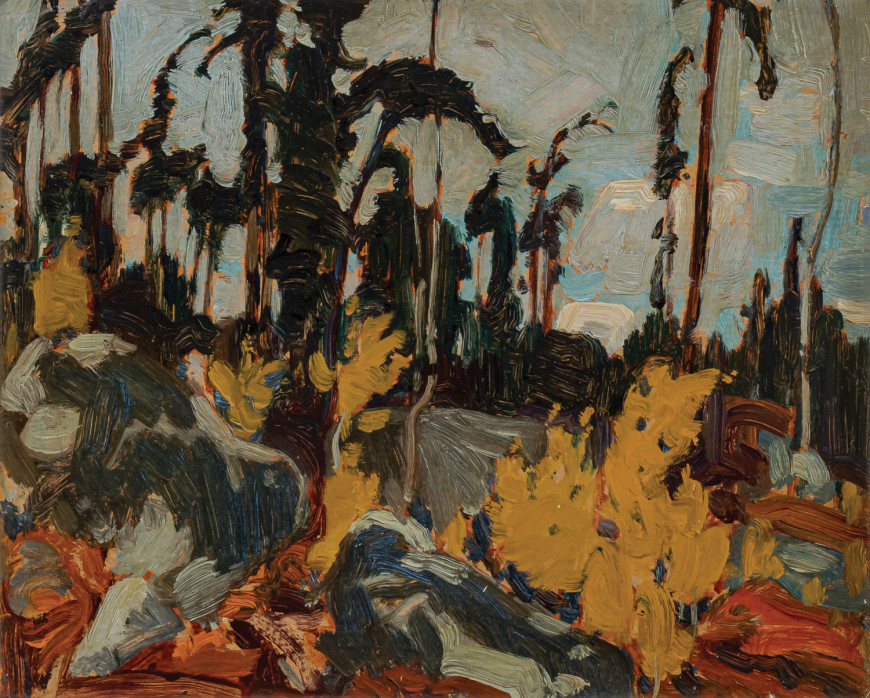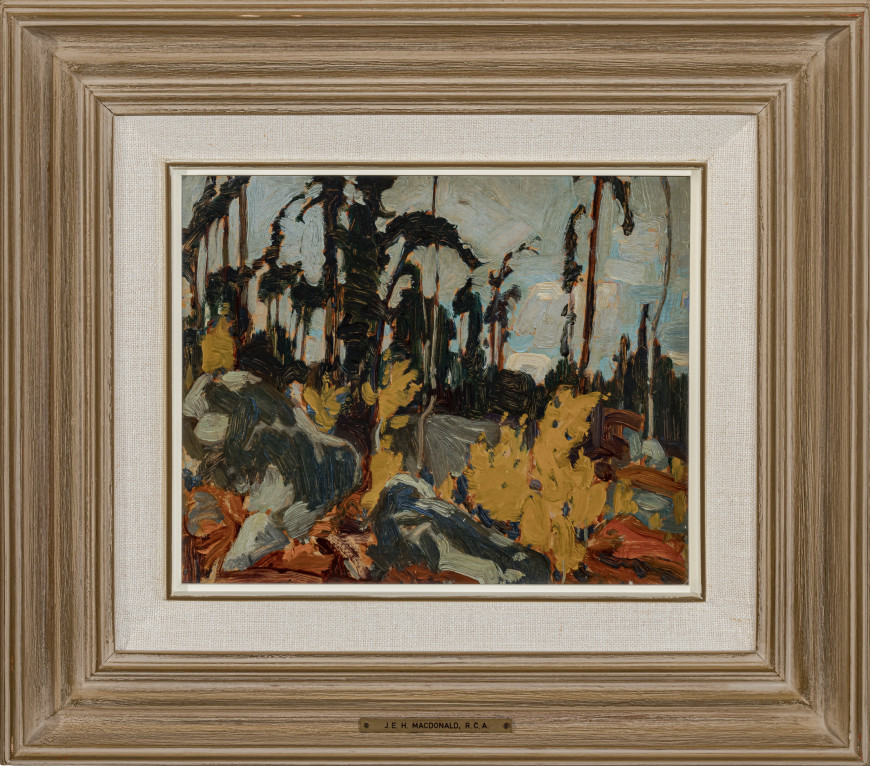-
Artworks
J.E.H. MacDonaldRocky Woods, Algoma, 19191873-1932Oil on panel8 1/2 x 10 1/2 in
21.6 x 26.7 cmSoldInscriptions
titled and signed, ‘Rocky Woods Algoma / J.E.H. MacDonald’ (verso, upper right)Provenance
Estate of the artist.
Galerie Walter Klinkhoff Inc., Montreal;Acquired from the above by Mitzi and Mel Dobrin.
Exhibitions
Toronto, Robert Simpson Co., 8-22 November 1924, Small Pictures by Members of the Ontario Society of Artists, no. 140 as Rocky Woods at $30"There is an energy and sensuousness in this superb painting that shows MacDonald at the height of his talents.
-Charles C. Hill
Born of a Canadian father and English mother near Durham, England in 1873, J.E.H. MacDonald moved to Hamilton, Ontario with his family in 1887 and to Toronto two years later. He worked for Grip Printing and Publishing Company from about 1894 and for Carlton Studio, founded by expatriate Canadians, in London, England from 1903 to 1907 when he returned to work at Grip Limited. One of Canada’s outstanding designers of the early twentieth century, MacDonald also became known for his paintings of Toronto and rural Ontario. However it was his painting of the garden at his home in Thornhill, just north of Toronto, that rocketed him to notoriety. Tangled Garden (National Gallery of Canada) was exhibited with the Ontario Society of Artists in 1916 and raised a howl of condemnation from journalists. Not daunted, his painting The Wild River (Faculty Club, University of Toronto) was met with equal journalistic distress when exhibited with the Ontario Society in the spring of 1919. When the same painting was included in an exhibition of his Algoma paintings with Lawren Harris and Frank Johnston the following month, it was a critical success. The message was clear, exhibitions of common subject matter painted in a shared visual language was the way to go. In May 1920 the Group of Seven held its first exhibition.
Algoma lay at the heart of the new movement during its founding years. Lawren Harris was the first to travel north of Sault Sainte Marie in the spring of 1918 and J.E.H. MacDonald would join his fellow artists travelling on the Algoma Central Railway in the autumns of 1918, 1919 and 1920. The changing colours of the Algoma landscapes stimulated MacDonald’s palette. In December 1919 he published his account of the 1919 Algoma trip, “A.C.R. 10557,” in the Arts and Letters Club periodical, The Lamps . “Every day advanced the passing of the leaf, and soon our painters had to go in quest of the desirable ‘spot of red.’ The hills that had been crimson and scarlet with maple were changed to purplish grey. The yellow leaves were following fast. … Birch woods, that were dense yellow in the morning, were [often] grey by night. But the wild cherry leaves still hung as though the high fifes and violins were to finish the great concert of color. They were another of the notable little graces of the bush, daintily hung in every shade from palest yellow to deep crimson against the big blue-gold hills of the Montreal Valley. … In this district many of the birches still held their leaves, but from a castle-like hill of rock which the painters favored, the hills lifted endlessly in the purple grey of bare trees, broken only with the dark spruce.”
Dense wood interiors caught MacDonald’s attention in September 1919 as seen in his sketches for The Beaver Dam (Art Gallery of Ontario) and Leaves in the Brook (McMichael Canadian Art Collection). In Rocky Woods, Algoma the paint is brushed on in broad, fluid rhythms with strong contrasts of colour, the yellows and oranges set against the greys, greens and blues of the rocks. The sky is energetically brushed in contrasting directions and the branches of the spindly firs reach out this way and that, dancing with the clouds. There is an energy and sensuousness in this superb painting that shows MacDonald at the height of his talents.
Charles C. Hill














